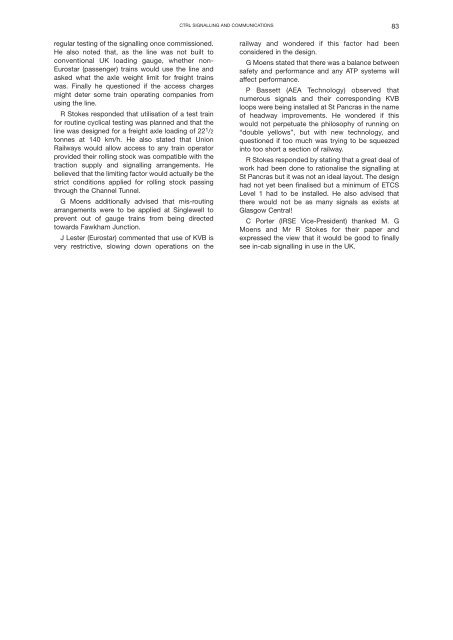Proceedings 2002/2003 - IRSE
Proceedings 2002/2003 - IRSE
Proceedings 2002/2003 - IRSE
You also want an ePaper? Increase the reach of your titles
YUMPU automatically turns print PDFs into web optimized ePapers that Google loves.
CTRL SIGNALLING AND COMMUNICATIONS 83<br />
regular testing of the signalling once commissioned.<br />
He also noted that, as the line was not built to<br />
conventional UK loading gauge, whether non-<br />
Eurostar (passenger) trains would use the line and<br />
asked what the axle weight limit for freight trains<br />
was. Finally he questioned if the access charges<br />
might deter some train operating companies from<br />
using the line.<br />
R Stokes responded that utilisation of a test train<br />
for routine cyclical testing was planned and that the<br />
line was designed for a freight axle loading of 22 1 /2<br />
tonnes at 140 km/h. He also stated that Union<br />
Railways would allow access to any train operator<br />
provided their rolling stock was compatible with the<br />
traction supply and signalling arrangements. He<br />
believed that the limiting factor would actually be the<br />
strict conditions applied for rolling stock passing<br />
through the Channel Tunnel.<br />
G Moens additionally advised that mis-routing<br />
arrangements were to be applied at Singlewell to<br />
prevent out of gauge trains from being directed<br />
towards Fawkham Junction.<br />
J Lester (Eurostar) commented that use of KVB is<br />
very restrictive, slowing down operations on the<br />
railway and wondered if this factor had been<br />
considered in the design.<br />
G Moens stated that there was a balance between<br />
safety and performance and any ATP systems will<br />
affect performance.<br />
P Bassett (AEA Technology) observed that<br />
numerous signals and their corresponding KVB<br />
loops were being installed at St Pancras in the name<br />
of headway improvements. He wondered if this<br />
would not perpetuate the philosophy of running on<br />
“double yellows”, but with new technology, and<br />
questioned if too much was trying to be squeezed<br />
into too short a section of railway.<br />
R Stokes responded by stating that a great deal of<br />
work had been done to rationalise the signalling at<br />
St Pancras but it was not an ideal layout. The design<br />
had not yet been finalised but a minimum of ETCS<br />
Level 1 had to be installed. He also advised that<br />
there would not be as many signals as exists at<br />
Glasgow Central!<br />
C Porter (<strong>IRSE</strong> Vice-President) thanked M. G<br />
Moens and Mr R Stokes for their paper and<br />
expressed the view that it would be good to finally<br />
see in-cab signalling in use in the UK.

















